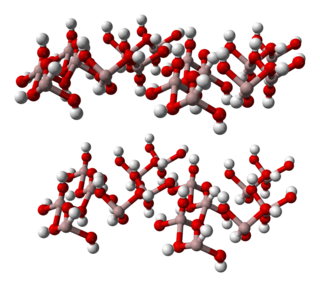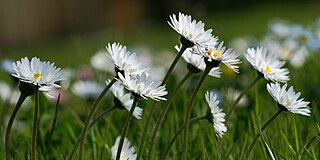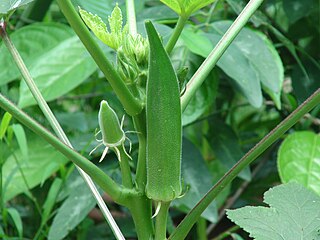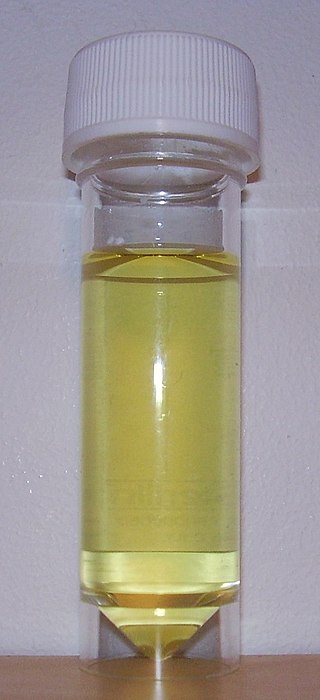Related Research Articles

A bean is the seed of several plants in the family Fabaceae, which are used as vegetables for human or animal food. They can be cooked in many different ways, including boiling, frying, and baking, and are used in many traditional dishes throughout the world.
Hydrolysis is any chemical reaction in which a molecule of water breaks one or more chemical bonds. The term is used broadly for substitution, elimination, and solvation reactions in which water is the nucleophile.

A fertilizer or fertiliser is any material of natural or synthetic origin that is applied to soil or to plant tissues to supply plant nutrients. Fertilizers may be distinct from liming materials or other non-nutrient soil amendments. Many sources of fertilizer exist, both natural and industrially produced. For most modern agricultural practices, fertilization focuses on three main macro nutrients: nitrogen (N), phosphorus (P), and potassium (K) with occasional addition of supplements like rock flour for micronutrients. Farmers apply these fertilizers in a variety of ways: through dry or pelletized or liquid application processes, using large agricultural equipment or hand-tool methods.

A condiment is a preparation that is added to food, typically after cooking, to impart a specific flavor, to enhance the flavor, or to complement the dish. A table condiment or table sauce is more specifically a condiment that is served separately from the food and is added to taste by the diner.

Soil pH is a measure of the acidity or basicity (alkalinity) of a soil. Soil pH is a key characteristic that can be used to make informative analysis both qualitative and quantitatively regarding soil characteristics. pH is defined as the negative logarithm (base 10) of the activity of hydronium ions in a solution. In soils, it is measured in a slurry of soil mixed with water, and normally falls between 3 and 10, with 7 being neutral. Acid soils have a pH below 7 and alkaline soils have a pH above 7. Ultra-acidic soils and very strongly alkaline soils are rare.

Aluminium hydroxide, Al(OH)3, is found in nature as the mineral gibbsite and its three much rarer polymorphs: bayerite, doyleite, and nordstrandite. Aluminium hydroxide is amphoteric, i.e., it has both basic and acidic properties. Closely related are aluminium oxide hydroxide, AlO(OH), and aluminium oxide or alumina, the latter of which is also amphoteric. These compounds together are the major components of the aluminium ore bauxite. Aluminium hydroxide also forms a gelatinous precipitate in water.
A sapric is a subtype of a histosol where virtually all of the organic material has undergone sufficient decomposition to prevent the identification of plant parts. Muck is a sapric soil that is naturally waterlogged or is artificially drained.

In biology, a tropism is a phenomenon indicating growth or turning movement of an organism, usually a plant, in response to an environmental stimulus. In tropisms, this response is dependent on the direction of the stimulus. Tropisms are usually named for the stimulus involved; for example, a phototropism is a reaction to sunlight.

Molluscicides – also known as snail baits, snail pellets, or slug pellets – are pesticides against molluscs, which are usually used in agriculture or gardening, in order to control gastropod pests specifically slugs and snails which damage crops or other valued plants by feeding on them.

Soil fertility refers to the ability of soil to sustain agricultural plant growth, i.e. to provide plant habitat and result in sustained and consistent yields of high quality. It also refers to the soil's ability to supply plant/crop nutrients in the right quantities and qualities over a sustained period of time. A fertile soil has the following properties:

Diammonium phosphate (DAP; IUPAC name diammonium hydrogen phosphate; chemical formula (NH4)2(HPO4) is one of a series of water-soluble ammonium phosphate salts that can be produced when ammonia reacts with phosphoric acid.

Okra or okro, Abelmoschus esculentus, known in some English-speaking countries as lady's fingers, is a flowering plant in the mallow family. It has edible green seed pods. The geographical origin of okra is disputed, with supporters of West African, Ethiopian, Southeast Asian, and South Asian origins. Cultivated in tropical, subtropical, and warm temperate regions around the world, okra is used in the cuisines of many countries.
A calcifuge is a plant that does not tolerate alkaline (basic) soil. The word is derived from the Latin 'to flee from chalk'. These plants are also described as ericaceous, as the prototypical calcifuge is the genus Erica (heaths). It is not the presence of carbonate or hydroxide ions per se that these plants cannot tolerate, but the fact that under alkaline conditions, iron becomes less soluble. Consequently, calcifuges grown on alkaline soils often develop the symptoms of iron deficiency, i.e. interveinal chlorosis of new growth. There are many horticultural plants which are calcifuges, most of which require an 'ericaceous' compost with a low pH, composed principally of Sphagnum moss peat.

Monocalcium phosphate is an inorganic compound with the chemical formula Ca(H2PO4)2 ("AMCP" or "CMP-A" for anhydrous monocalcium phosphate). It is commonly found as the monohydrate ("MCP" or "MCP-M"), Ca(H2PO4)2·H2O. Both salts are colourless solids. They are used mainly as superphosphate fertilizers and are also popular leavening agents.

Urine is a liquid by-product of metabolism in humans and in many other animals. Urine flows from the kidneys through the ureters to the urinary bladder. Urination results in urine being excreted from the body through the urethra.
An acidophobe is an organism that is intolerant of acidic environments. The terms acidophobia, acidophoby and acidophobic are also used. The term acidophobe is variously applied to plants, bacteria, protozoa, animals, chemical compounds, etc. The antonymous term is acidophile.

A pitaya or pitahaya is the fruit of several different cactus species indigenous to the region of southern Mexico and along the Pacific coasts of Guatemala, Costa Rica, and El Salvador. Pitaya is cultivated in East Asia, South Asia, Southeast Asia, the United States, the Caribbean, Australia, and throughout tropical and subtropical regions of the world.
Chalk heath is a rare habitat, in the temperate grasslands, savannas, and shrublands biome, formed of a paradoxical mixture of shallow-rooted calcifuge ("calcium-hating") and deeper-rooted calcicole ("calcium-loving") plants, growing on a thin layer of acidic soil over an alkaline substrate. Chalk heath is intermediate between two much more widespread habitats, chalk grassland and heathland.
Agrobiology is defined by Merriam-Webster as a field that studies how plant or crop nutrition, growth, and yield or production relate to soil management (Merriam-Webster). Agrobiology is an interdisciplinary field of study that provides a comprehensive understanding of the complex relationships between crops, soils, and the environment. Agrobiology consists of several science-based disciplines including, plant biology and nutrition, agronomy, ecology, genetics, molecular biology, and soil science. Prominent topics that involve agrobiology practices include the following but are not limited to, the role of soil microbiota in both conventional and sustainable agriculture systems, the effects of integrating livestock in sustainable agriculture systems, and the use of biotechnology and its relationship to agrobiology.
References
- ↑ Anon. "Calcicole". The World Dictionary. Dictionary.com. Retrieved 18 February 2012.
- ↑ Anon. "Calciphile". Merriam Webster free dictionary. Merriam Webster. Retrieved 18 February 2012.